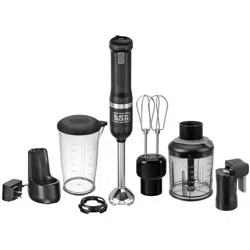Loading ...
Loading ...
Loading ...

9
ENGLISH
Important Safety Instructions for All
Battery Chargers
WARNING: Read all safety warnings, instructions,
and cautionary markings for the battery, charger
and product. Failure to follow the warnings and
instructions may result in electric shock, fire and/
or seriousinjury.
• DO NOT attempt to charge the battery with any
chargers other than a BLACK+DECKER charger.
BLACK+DECKER chargers and batteries are specifically
designed to worktogether.
• These chargers are not intended for any uses other
than charging BLACK+DECKER rechargeable
batteries. Charging other types of batteries may cause
them to overheat and burst, resulting in personal injury,
property damage, fire, electric shock orelectrocution.
• Do not expose the charger to rain orsnow.
• Do not allow water or any liquid to entercharger.
• Pull by the plug rather than the cord when
disconnecting the charger. This will reduce the risk of
damage to the electric plug andcord.
• Make sure that the cord is located so that it will not
be stepped on, tripped over or otherwise subjected to
damage orstress.
• Do not place any object on top of the charger. Place
the charger in a position away from any heatsource.
• Do not operate the charger with a damaged cord
orplug–have them replacedimmediately.
over or damaged in any way (e.g., pierced with a nail, hit
with a hammer, stepped on). Damaged tools should be
returned to the service center forrecycling.
Storage Recommendations
The best storage place is one that is cool and dry, away
from direct sunlight and excess heat or cold. Store the fully
charged tool disconnected from thecharger.
Transportation
NOTE: Integral Li‑ion tools should not be put in checked
baggage on airplanes and must be properly protected from
short circuits if they are in carry‑onbaggage.
Tool Disposal
This product uses a lithium‑ion rechargeable
and recyclable battery. When the battery
no longer holds a charge, the tool should
be recycled. The tool should not be
incinerated or placed in the trash or curbsiderecycling.
The tool can be taken for disposal to an Authorized Service
Center. Some local retailers are also participating in a national
recycling program (refer to RBRC®). For more information visit
www.call2recycle.org or call the toll‑free number in the
RBRC Seal. RBRC is a registered trademark of Call 2Recycle,
Inc. If you bring the tool to an Authorized Service Center,
the center will arrange to recycle the tool and its battery.
Or, contact your local municipality for proper disposal
instructions in your city/town.
READ ALL INSTRUCTIONS
Important Safety Instructions for All
Integral Battery Tools
WARNING: Read all safety warnings, instructions,
and cautionary markings for the battery, charger
and product. Failure to follow the warnings and
instructions may result in electric shock, fire and/
or seriousinjury.
• NEVER force a charger plug to fit thetool.
• DO NOT
modify the charger plug of a non‑compatible
charger in any way to fit the tool as the battery may
rupture causing serious personalinjury.
• DO NOT charge or use the battery in explosive
atmospheres, such as in the presence of flammable
liquids, gases or dust. Inserting or removing the charger
plug from the tool may ignite the dust orfumes.
• Only charge the battery with the providedcharger.
• DO NOT splash or immerse in water or otherliquids.
• DO NOT allow water or any liquid to entertool.
• DO NOT store or use the tool in locations where the
temperature may reach or exceed 104°F (40°C) (such
as outside sheds or metal buildings in summer). For
best life store tools in a cool, drylocation.
NOTE: Do not store the tool with the switch locked on.
Never tape the switch in the ONposition.
• DO NOT incinerate the tool even if it is severely
damaged or is completely worn out. The battery can
explode in a fire. Toxic fumes and materials are created
when lithium‑ion batteries areburned.
• If battery contents come into contact with the skin,
immediately wash area with mild soap and water. If
battery liquid gets into the eye, rinse water over the open
eye for 15minutes or until irritation ceases. If medical
attention is needed, the battery electrolyte is composed of a
mixture of liquid organic carbonates and lithiumsalts.
• Contents of opened battery cells may cause
respiratory irritation. Provide fresh air. If symptoms
persist, seek medicalattention.
• Battery liquid may be flammable if exposed to spark
orflame.
• Never attempt to open the tool for any reason. If the
tool case is cracked or damaged, do not charge. Do
not crush, drop or damage the tool. Do not use a tool or
charger that has received a sharp blow, been dropped, run
Ah ....................... amp hours
or AC ...........alternating current
or AC/DC .... alternating or direct
current
...................... Class II Construction
(double insulated)
n
o
.......................no load speed
n .........................rated speed
PSI....................... pounds per square
inch
......................earthing terminal
.....................safety alert symbol
..................... visible radiation–
do not stare into
the light
..................... wear respiratory
protection
..................... wear eye protection
..................... wear hearing
protection
..................... r
ead all documentation
.....................
do not expose to rain
Loading ...
Loading ...
Loading ...
